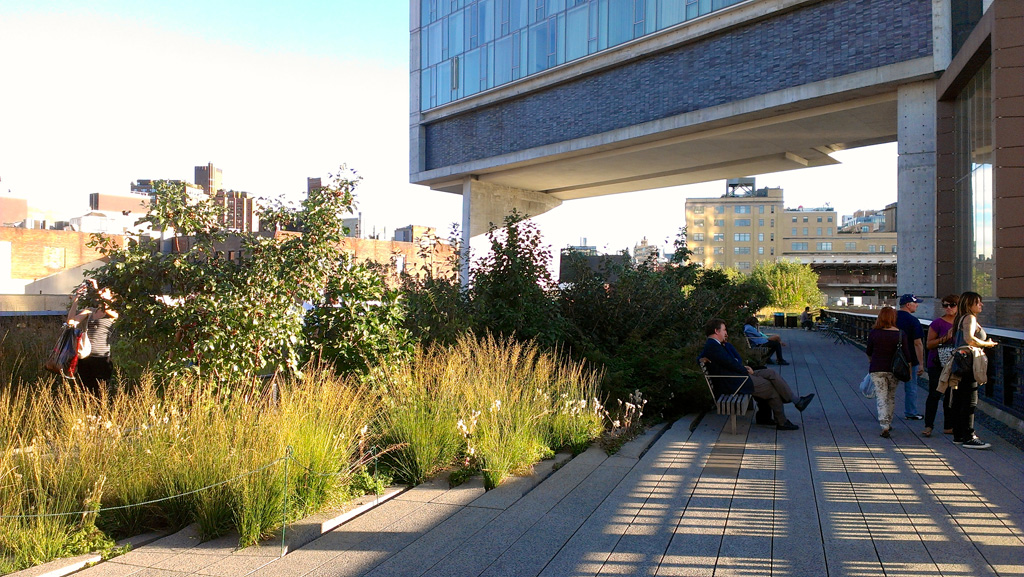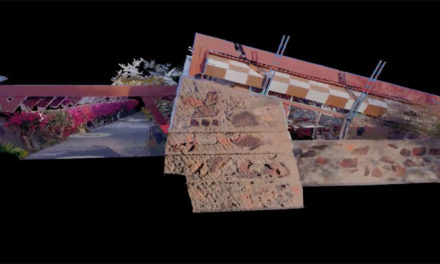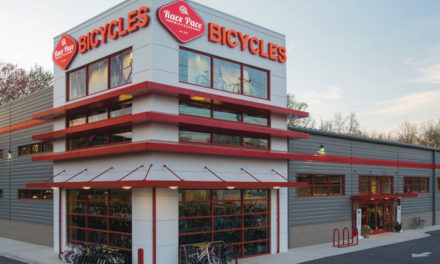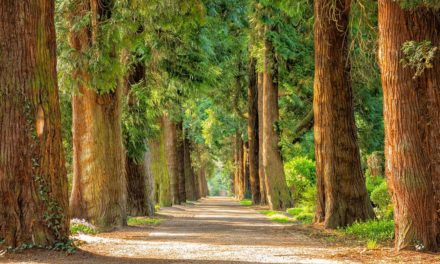In today’s society, sectors across industry are reaping the economic benefits of biophilic design. By examining five of these sectors—workplaces, healthcare, retail stores, schools, and communities—we can begin to understand the fiscal implications of biophilic design across the economy. The numbers and percentages presented reflect powerful evidence that design and planning strategies informed by nature can lead to positive impacts on human health, child development, community safety, and worker satisfaction. These effects translate directly to increased profits.
Property Value, Crime, and Well-Being – The Cost Benefits of Nature in Communities
Communities are economic webs consisting of homes, parks, transportation nodes, commercial spaces, and public buildings. The people in communities, both permanent and transient, interact with and affect this ecosystem. The same can be said in reverse; physical and spatial characteristics of communities affect people, both psychologically and physiologically. Nature, as one characteristic, plays an important role in the experience of communities. As human settlements continue to densify—68% of the world population is projected to reside in cities by 2050—one’s experience in communities will invariably change (United Nations, 2018). Yet human’s innate desire to affiliate with nature will not.
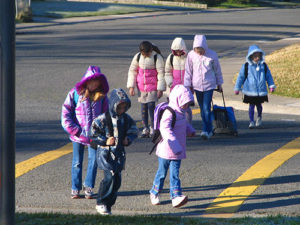
Children Crossing Street, Courtesy of Dan Burden (www.pedbikeimages.org)
The value of nature in communities is illuminated by human decision-making. When people are deprived access to nature and its many benefits, there are economic consequences—specifically in health and societal costs. Conversely, the added benefit to humans is calculable and substantial. Access to parks and views to nature within a community may be a cost-effective strategy to reduce the impact of our medical and social problems. To this end, we can quantify in dollars the importance of providing people with access to nature in the built environment and reveal the economic value of trees, parks, and other forms of nature in neighborhood design.
Hedonic Value & Real Estate
People are willing to pay more for close proximity to green space and good views—in particular, views of distance, water, and mature trees. In economic terms, this price premium describes Hedonic Value, or the value one places on the pleasure they derive from an experience or product. The purpose of investment in the enjoyment and desirability of a communities is to increase the valuation of community real estate, and the tax base this real estate creates. Greenery, especially in dense urban settings, has been shown to increase the desirability and subsequent value of real estate. In Washington D.C., for instance, researchers at the Trust for Public Land estimated a 5% premium on those properties within 500 feet of a park (Harnik & Well, 2009). In aggregate, these modest increases in real estate value can greatly increase city tax base. Economists at Appleseed Inc. analyzed the increased value that central park provides to the city of New York. As just one facet of that value, they estimated the addition of $26 billion in market value to properties within two tax block groups closest to the park. (Appleseed Inc, 2015).
Furthermore, real estate premiums have been found, not only in close proximity to large, formal parks, like Central Park, but also to small greening improvements in otherwise nature-devoid urban locations. This approach has come to be known as biophilic urban acupuncture. Perhaps the most common example of biophilic urban acupuncture is the community garden. Often transforming vacant and degraded plots, these neighborhood public spaces have marked impacts on real estate value. Voicu and Been (2008) measured the value added by community gardens across New York City. Focusing on properties within a 1,000 square foot radius of a community garden, they calculated increased tax revenue from real estate sale premiums, along with cost to construct and operate a community garden across 20 years. According to their calculations, each community garden realized a net tax benefit of $512,000 for surrounding real estate over 20 years. In aggregate, the City’s estimated present value of net tax benefits over 20 years was found to be $325 million (Voicu and Been, 2008).
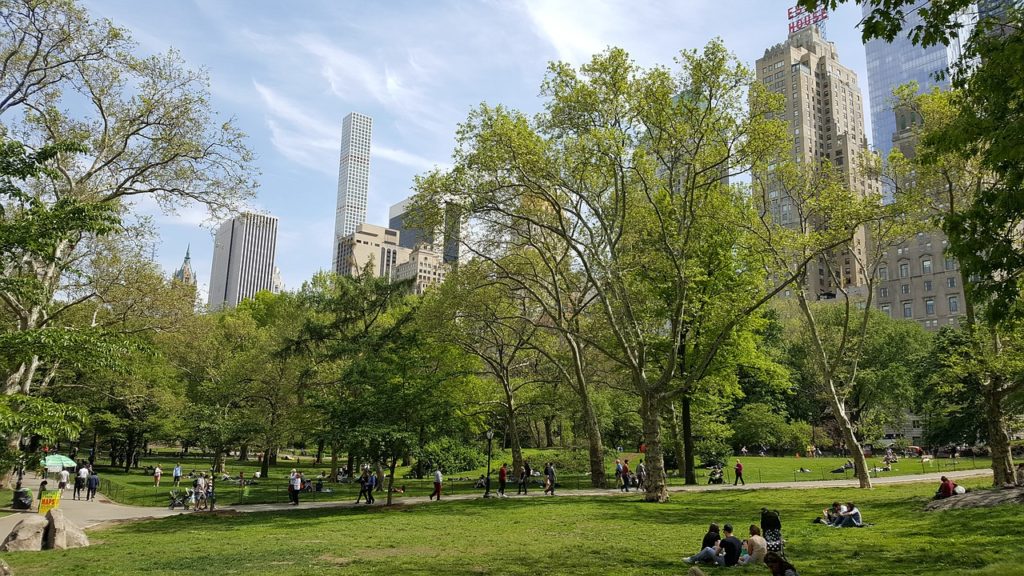
Central Park, New York City
Community Cohesion
Access to nature also contributes to the actions and social behavior of communities. Cognitive studies have shed light on the benefits of interactions with nature, such as reduced hostility among prison inmates after participating in gardening projects and fewer reports of mental anguish for poverty-stressed, inner-city residents. Nature’s calming influence even reduces mental fatigue and outbursts of anger. To test this notion, Kuo and Sullivan conducted a study of 145 urban public housing residents with varying proximity to spaces of nature. Space ranged from green (ample trees) to barren (no visible trees). Levels of mental fatigue were compared using Digit Span Backwards (DSB) tests, which attribute inability to concentrate to mental fatigue. Residents living in green settings demonstrated higher scores in attention span and reliability. Furthermore, the results of the study found that some types of domestic violence were 25% less prevalent in the greener housing developments compared to the barren housing cluster (Kuo & Sullivan, 2001a).
Another 2001 study by Kuo and Sullivan measured the difference in crime rates over a two-year period, in a large public housing development in urban Chicago. A section of buildings that was surrounded by greenery was compared with another that was devoid of surrounding nature. The study reported 52% fewer felonies in the greener buildings, 7-8 % of which could be linked to increased access to nature (Kuo & Sullivan, 2001b). Applied across Chicago’s 14 family-aimed public housing developments, assuming that the rates of crime remain fairly consistent across each development, and assuming that each of these felonies resulted in arrest and incarceration, we estimate that this results in a rough savings of $189,300 to the Illinois Department of Corrections each year (Chicago Housing Authority 2018, Durose & Langan, 2003). This number, as with all of our other estimates, is intended merely as a rough estimate of the cost-savings attributable to biophilic design. It also takes into consideration only reduced crime and does not consider the myriad other health and operational benefits of biophilic design (see full report appendix).
As an observation separate from the statistical analysis of the Kuo and Sullivan study, housing developments with large trees have been found to attract people to be outdoors, talk with neighbors, and develop stronger social bonds (Heerwagen, 2006). The conclusions from these studies provide possible interventions for reducing aggression and violence in the inner city. From a community standpoint, the amount of substantiated evidence linking decreased conflictive behavior with the integration of greenery and vegetation in communities shows that it is worthwhile, both economically and socially, to incorporate biophilia into urban design.
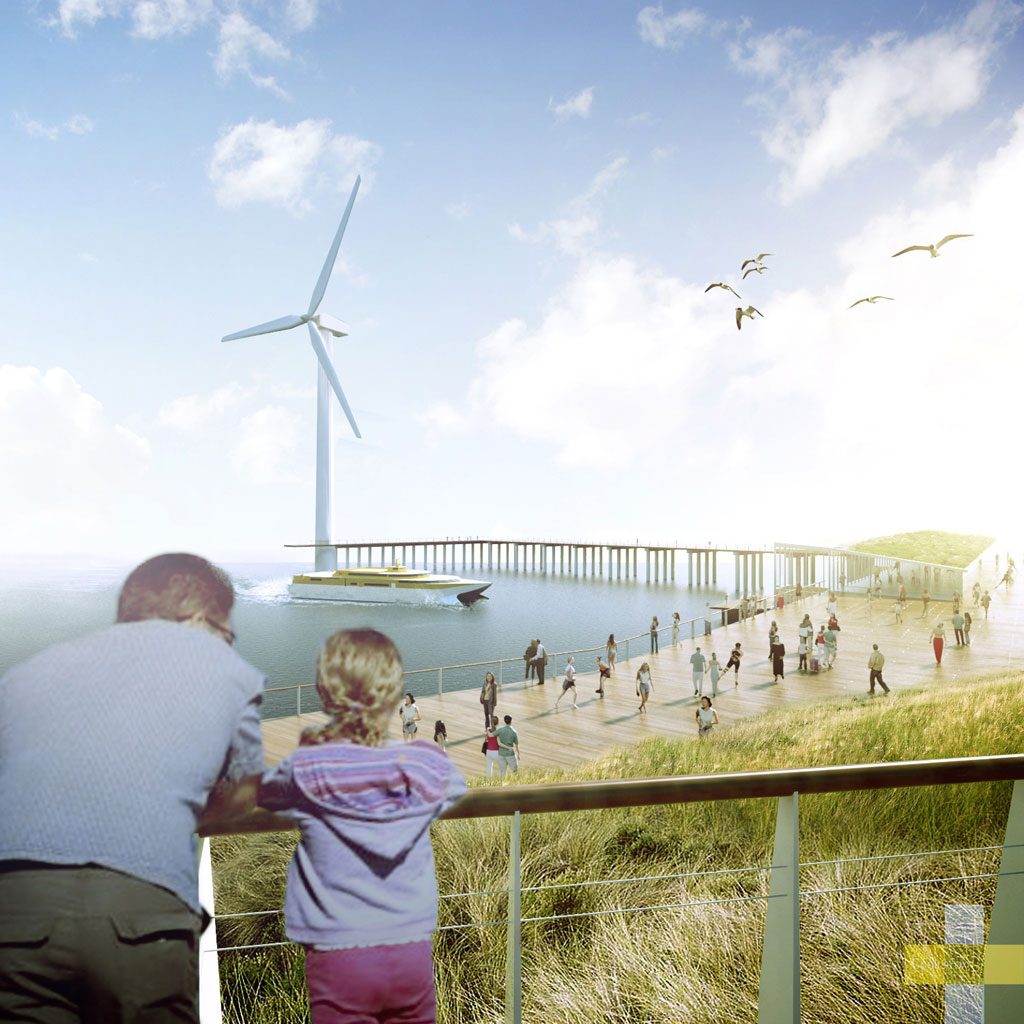
Nature Affects Health: The benefits of biophilia include improved stress recovery rates, lower blood pressure, improved cognitive functions, enhanced mental stamina and focus, decreased violence and criminal activity, elevated moods, and increased learning rates. – Joye, 2007. Pier Rendering, Courtesy of COOKFOX Architects
Health
Many of the developed world’s leading health crises, including obesity, Type II diabetes, high blood-pressure heart disease and certain cancers, stem from an increasingly sedentary, indoor lifestyle (John Hopkins Medicine, n.d.). According to the Center for Disease Control and Prevention (2016) only 22.7% of American adults meet the exercise requirements set by the Federal 2008 Physical Activity Guidelines. The character of a community, as determined by numerous environmental factors, affect decisions to engage in physical activity during leisure time. For example, lack of parks, sidewalks and sports/recreation facilities, low air quality, dense traffic, and violence, discourage participation in outdoor physical activity for highly urbanized communities (World Health Organization, 2008).
Among these environmental factors, several studies have cited proximity to green space and tree density as correlating with increased outdoor physical activity. In one study, researchers found that people who use public open spaces are three times more likely to meet recommended physical activity levels (Giles-Corti et al., 2005). Another study found participants took more walking trips when the route was believed to include more natural features. Participants also overestimated distance in neighborhoods with less greenery, likely attributing to fewer walks (Tilt, Unfried, and Roca, 2007).
Furthermore, subjective perception of health has also to correlate with community greenery. Using satellite imagery and city planting data, Kardan et al. (2015) approximated tree density across the city. Researchers then compared that data with survey results from participants around the city, finding that those in higher tree density locations reported significantly higher health perception and significantly less cardio-metabolic conditions. From their results, Karden et al. (2015) concluded that having 10 more trees in a city block increased health perception to the same degree as $10,000 more in annual income or being 7 years younger.
Walks in community park spaces may also reduce the behavioral symptoms of ADHD. In 2009, 16 children, all diagnosed with either ADD or ADHD, were exposed to three settings with varying degrees of greenery: a park setting (most greenery), a neighborhood street (modest greenery), and a downtown area (no greenery). Based on the level of “green dosage” provided to the children, the children experienced significantly greater ability to concentrate and greater positive attention rates after walking in the park compared with the other two environments. This suggests that exposing children with attention deficits to a natural environment can substantially enhance their attention performance (Taylor & Kuo, 2009). There are 5.2 million children in America diagnosed with ADHD, and $2.28 billion is spent on ADHD medication alone. In fact, the average family that purchases ADHD medication pays $25-109 per month for it (Scheffler et al., 2007). If providing children access to parks and nature within a community reduced the medication intake by a conservative 10%, families nationwide could save a cumulative $228 million in ADHD medication in 2004 numbers. Considering that Scheffler et al. have measured an annual growth rate in expenditures on ADHD medication of 22.6%, the savings resulting from a reduced consumption will increase proportionally as well (see full report appendix).
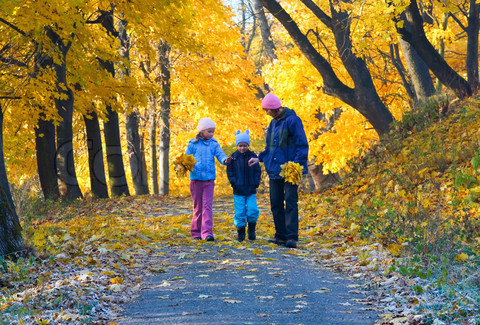
Valuing a walk in the park: Children with ADHD who take a 20-minute walk through a park are likely to exhibit significantly better concentration than by doing the same in a downtown area. Nature has major implications for the way we treat ADHD. – Taylor & Kuo, 2009.
Family on Nature Walk, Courtesy of Colourbox.com
Another study found that teenage girls develop better when they have views to nature from their homes. In a study of self-discipline in teenage girls, those with green space immediately outside their homes demonstrated more self-discipline than those without, by a margin of 20%. Self-discipline was measured as a function of concentrating, inhibiting initial impulses, and delaying gratification (Taylor et al., 2001). Mastery of these personal skills often results in higher rates of professional, academic and personal success. As budgets across the country are cut for inner-city landscaping, children are deprived of resources that develop their self-discipline and meet their psychological needs.
From Theory to Practice
City leaders and community members alike are recognizing the benefits of biophilic design in creating desirably, healthy, and happy communities. Whether it be a community program to transform vacant lots, a multi-million-dollar construction project, or a city-wide mandate for green roofs, biophilic interventions are taking hold in communities around the world, often with results to prove their economic success.
One of the most successful examples of urban greening is the High Line, running along the western waterfront of New York City. Though anticipating 300,000 visits to the High Line in 2009, 1.3 million were recorded. Visits per year have more than quintupled in the time since, climbing to 7.6 million in 2015 (Ganser, 2017). The desire to walk along a nature-filled path was clearly underestimated. While surrounding commercial ventures saw little benefit to its proximity before redevelopment, the area has now experienced a resurgence in retail sales, lodging prices, and new development due to this well-known attraction. One study found residential real estate within one-third of a mile from the park to have increased 10% immediately following the park opening in 2009 (Levere, 2014). The study went on to estimate that increased property taxes in 2010 alone to have nearly surpassed the park’s construction costs.
In addition to investment in greening projects, many cities have effected change through top-down development goals and zoning mandates. Singapore, a city-state whose population has more than doubled to 5 million in the last 25 years, has shown tremendous leadership in this arena. Recognizing opportunity to define their own development goals, Singapore government and urban planners devised a Green Plan aimed at luring investment into the area. In the process, its green coverage on rooftops and in parks has increased from slightly greater than one-third of the city’s area to almost one half the entire area of Singapore (Kolesnikov-Jessop, 2011). The city’s 10-year development plan seeks to transform and revitalize Singapore from being the “Garden City” to the international “City in a Garden”, while simultaneously becoming a leader in economic markets. Experts anticipate Singapore will expand as a global hub for innovation, markets, business, and entrepreneurs (Ministry of National Development, Singapore, 2011). Singapore is catching hold of a revolutionary concept as they continue to identify greenery as part of a strategy to lure investment and drive economic growth that concurrently increases quality of life and delivers more business to the city every year.
Integration of green space into urban design cultivates a society that is more aware and invested in a long-term shift toward generations that are healthier, more productive, and more connected to nature. This shift could be manifested in an increase in the agency of marginalized or overlooked sections of the future labor force. Another way of addressing this could be a change in the structure of the real estate landscape. Recognizing the premiums that green properties generate could change building codes and best practices in construction in the long run, resulting in urban areas that move towards reconnecting with the native landscape. The fact that these kinds of changes are already used to highly positive effect in cities like Singapore, should encourage governments, urban designers, developers and architects to follow their lead.
“The Economics of Biophilia” is a six-part republication of “The Economics of Biophilic Design” by Terrapin Bright Green. As a series, each section explores one of five economic indicators as it relates to biophilic design: workplace, healthcare, education, retail, and community.
Work References:
Appleseed Inc. (2015). The central park effect: Assessing the value of central park’s contribution to New York City’s economy. Appleseed Inc.
Center for Disease Control and Prevention. (2016). Health, United States, 2017: Table 57. Participation in leisure-time aerobic and muscle-strengthening activities that meet the federal 2008 Physical Activity Guidelines for Americans among adults aged 18 and over, by selected characteristics: United States, selected years 1998–2016. National Center for Health Statistics.
Chicago Housing Authority. (2018). Housing. Retrieved from http://www.thecha.org/residents/public-housing
Durose, Matthew, Patrick A. Langan. (2003). State Court Sentencing of Convicted Felons,U.S. Bureau of Justice Statistics. Office of Justice Programs.
Ganser, A. (2017). High Line Magazine: B1G DA+A and Parks. Friends of the High Line. Retrieved from https://www.thehighline.org/blog/2017/01/18/high-line-magazine-b1g-daa-and-parks/
Giles-Corti, B., M.H. Broomhall, M. Knuiman, C. Collins, K. Douglas, K. Ng, A. Lange, and R.J. Donovan. (2005). Increasing Walking: How Important is Distance to, Attractiveness, and Size of Public Open Space? American Journal of Preventive Medicine, 28:169-176.
Harnik, P., & Welle, B. (2009). Measuring the Economic Value of a City Park System. The Trust for Public Land. Washington, D.C.
Heerwagen, J.H. (2006). Investing in People: The Social Benefits of Sustainable Design. Presented at Rethinking Sustainable Construction. Sarasota, FL.
John Hopkins Medicine. (n.d.). Health Library: Risks of Physical Inactivity. Retrieved from https://www.hopkinsmedicine.org/healthlibrary/conditions/cardiovascular_diseases/risks_of_physical_inactivity_85,p00218
Kardan, O., Gozdyra, P., Misic, B., Moola, F., Palmer, L.J. Paus, T., & Berman, M.G. (2015). Neighborhood greenspace and health in a large urban center. Nature, scientific report 5; article 11610. doi:10.1038/srep11610
Kolesnikov-Jessop, S. (2011). An Urban Jungle for the 21st Century. The New York Times. New York: NY.
Kuo, F.E., & Sullivan, W.C. (2001a). Aggression and Violence in the Inner City: Effects of Environment via Mental Fatigue. Environment and Behavior, 33(4):543-571. Sage Publications.
Kuo, F.E., & Sullivan, W.C. (2001b). Environment and Crime in the Inner City: Does Vegetation Reduce Crime?. Environment and Behavior, 33(3):343–367. Sage Publications.
Levere, M. (2014). The High Line park and timing of capitalization of public goods. Department of Economics, University of California San Diego. Retrieved from http://docplayer.net/42473681-The-high-line-park-and-timing-of-capitalization-of-public-goods.html
Ministry of National Development, Singapore. (2011). “From Garden City to City in a Garden.” Singapore.
Scheffler, R.M., Hinshaw, S.P., Modrek, S., & Levine, P. (2007). The Global Market for ADHD Medications. Health Affairs, 26(2): 450–457.
Taylor, A., and Kuo, F.E. (2009). Children with attention deficits concentrate better after walk in the park. Journal of Attention Disorders, 12; 402. SAGE Publications.
Taylor, A., Kuo, F.E., & Sullivan, W.C.. (2001). Views of Nature and Self-Discipline: Evidence from Inner City Children. Journal of Environmental Psychology, 22(1-2): 49-63. Web.
Tilt, J.H., T.M. Unfried, and B. Roca. (2007). Using Objective and Subjective Measures of Neighborhood Greenness and Accessible Destinations for Understanding Walking Trips and BMI in Seattle, Washington. American Journal of Health Promotion 21, 4:371-379.
United Nations. (2018). World Urbanization Prospects: The 2018 Revision. Retrieved from https://population.un.org/wup/Publications/Files/WUP2018-KeyFacts.pdf
Voicu, I., & Been, V. (2008). The effect of community gardens on neighboring property values. Real Estate Economics, 36(2): 241-283.
World Health Organization. (2008). Physical Inactivity: A Global Public Health Problem. Retrieved from https://www.who.int/dietphysicalactivity/factsheet_inactivity/en/

